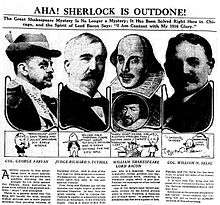George Fabyan

George Fabyan (1867 – 1936) was a millionaire businessman who founded a private research laboratory.[1] Fabyan's laboratory pioneered modern cryptography, though its initial findings, supporting Fabyan's belief that Francis Bacon wrote Shakespeare's plays, were later disproven by the cryptographers who trained there.
Early life
Born in Boston to George and Isabella Fabyan, the second child and eldest son of five children, he left home at age 17. Eventually ending up in Chicago, he ran the Chicago office of his tycoon-father's textile business Bliss, Fabyan & Co. from 1895 on. Inheritance from Bliss, Fabyan & Co. provided the financial foundation from which he and his wife, Nelle, established their legacy.
Illinois Governor Richard Yates appointed George Fabyan to his military guard in 1901, giving him the honorary title of Colonel, by which he was generally later known.[2]
In May 1909 Fabyan was awarded the Order of the Rising Sun by the Japanese government for his service to same. Fabyan had spent some time in Japan before 1905, developing relations with Japanese government and business representatives. He also was appointed as a liaison to General Kuroki Tamemoto during the Russo-Japanese peace negotiations (Treaty of Portsmouth) held in Maine in 1905. Between 1907 and 1910, he served as a host for General Kuroki, Baron Komura, and Prince Fushimi during their visits to Chicago.
Properties
He and his wife developed a 300+ acre country estate in Geneva, Illinois, 40 miles west of Chicago, beginning with the purchase of 10 acres on the west bank of the Fox River. "Riverbank", as they named their estate, featured among other things, a Japanese Garden, private zoo, Roman-style swimming pool, gardens, grottoes, greenhouses, a farm and the research laboratory. They lived on their estate from 1908 to 1939 in a farmhouse remodeled by Frank Lloyd Wright, which they called the Fabyan Villa. This site also contained George's and Nelle's expansive private library and museum.[3]
In 1914 Fabyan purchased and had moved a Dutch-style windmill built c. 1870 from its original farm site in York Center, IL to his estate. Known as the Fabyan Windmill, this 5-story grist mill was restored to working order in 2004.[4]
Baconian theory

Fabyan supported the Baconian theory, which was popular at the time, that Shakespeare's plays were written by Francis Bacon. He established a cryptologic research group to study alleged ciphers in Shakespeare's work.[1][5] Known as Riverbank Laboratories, it was the first privately owned research facility in the United States.[6]
In 1916 William Nicholas Selig, a film producer, sued Fabyan on the grounds that profits from forthcoming films of Shakespeare's works, along with a film on the life of Shakespeare, would be damaged by Fabyan's claims that Bacon was the author. He had already obtained an injunction stopping the publication of a book by Fabyan on the subject. Selig was intending to capitalise on the celebrations organised for the upcoming 300th anniversary of Shakespeare's death, which occurred in April 1616. A Cook Country Circuit Court judge, Richard Tuthill, found against Shakespeare's authorship. He determined that the bi-literal ciphers identified by Fabyan's analyst Elizabeth Wells Gallup were authentic and that Francis Bacon was therefore the author of the works. Damages of $5,000 were awarded to Fabyan for the interference with the publication of the book. In the ensuing uproar, Tuthill rescinded his decision, and another judge, Judge Frederick A. Smith, dismissed the ruling.[7][8][9] It was later suggested by the press that the case was concocted by both parties for publicity, since Selig and Fabyan were known to be old friends.[10][11]
American cryptologist William F. Friedman worked for Fabyan, initially in the genetics department of his laboratory, but later in the cipher department.[12] There he met another of Fabyan's cryptologists, the woman who was to become his wife, Elizebeth Friedman. Both were employed to assist Elizabeth Wells Gallup. However, they eventually discredited the ciphers that Gallup claimed to have discovered. They won the Folger Shakespeare Library Literary Prize of $1000 in 1955 for a definitive study that is considered to have disproven the claims of all researchers that the works of Shakespeare contain hidden ciphers that disclose Bacon's — or any other candidate's — secret authorship. The study was condensed and published in 1957 as The Shakespeare Ciphers Examined.
World War I
The Friedmans played a significant role in World War I. Nearly all American military World War I cryptography was done at Fabyan's laboratories. In particular they uncovered a plot against the British by Indian nationalists supported by the Germans. In fact, the National Security Agency has recognized Riverbank Laboratories as the birthplace of cryptology and finally honored Fabyan in 1992 for his service to the United States' government/military in 1917-18.
References
- 1 2 George Fabyan, Wealthy Eccentrics, CNN
- ↑ The Fabyan Forest Preserve and Villa Museum, onthefox.com
- ↑ "Riverbank Labs". Geneva, Illinois U.S.A.: City of Geneva.
- ↑ Fabyan WIndmill, Kane County Forest Preserve District
- ↑ Cryptologic Almanac, National Security Agency
- ↑ Riverbank Labs
- ↑ McMichael & Glenn 1962, p. 199
- ↑ Wadsworth 1958, pp. 74–75
- ↑ Niederkorn 2004, pp. 82–5
- ↑ Rose Sheldon, The Friedman Collection: An Analytical Guide, item 1365.
- ↑ Richard Bentley, "Elizabethan Whodunnit: Who was William Shakespeare", American Bar Association Journal, Feb 1959, vol 45, p203.
- ↑ Gilbert, James L.; Finnegan, John P., eds. (1993), U.S. Army Signals Intelligence In World War II: A Documentary History (PDF), United States Army Center of Military History, p. 18, CMH Pub 70-43
External links
- The George Fabyan Collection From the Rare Book and Special Collections Division at The Library of Congress